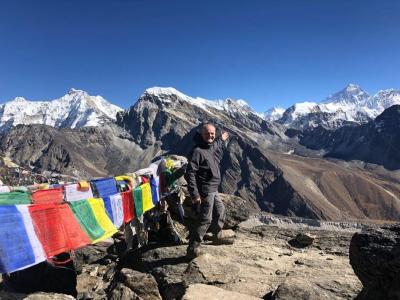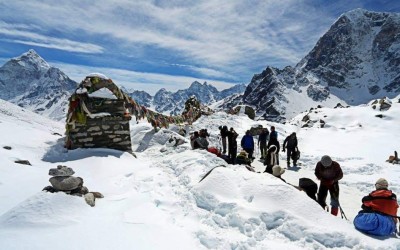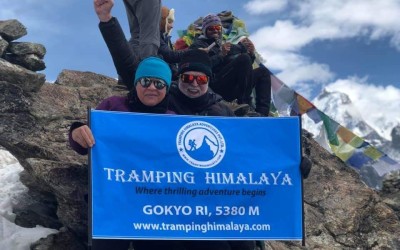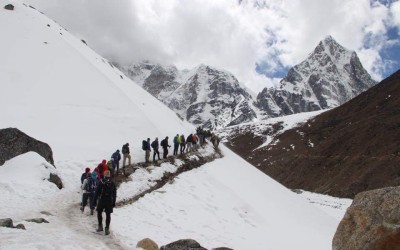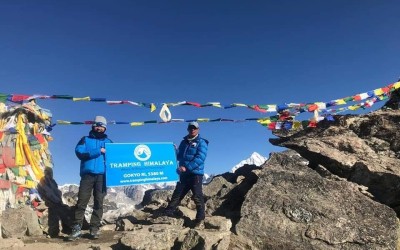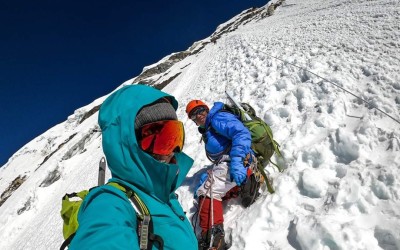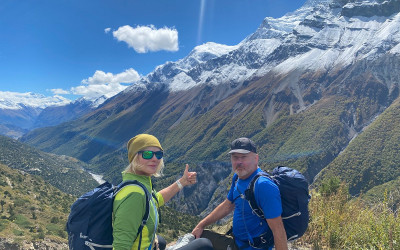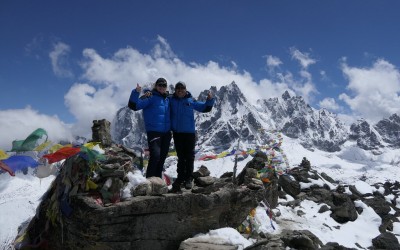Trip At Glance
-
Group Size2-15 Persons
-
Max ElevationKalapatthar at 5,545 m
-
GradeModerate to Adventurous
-
DestinationNepal
-
TransportationFlight/Tourist Bus/Private Car
-
AccommodationHotel/Lodge
-
CostContact Us
-
Trip Length20 days
-
Best MonthSpring & Autumn
-
WIFIAvailable
-
RegionEverest Region
-
Trip ModeTea House
-
MealB/L/D
-
Trekking StyleTea House
overview
Trip Overview
Three High Passes of Everest Trekking in Nepal is the challenging trip for the Himalayan wilderness adventure. Up in the high altitude passes of the Everest region, the journey epitomizes perseverance, intrepidity, and sheer mountain madness. Test your limit! Experience the mini-mountaineering feeling without doing any kinds of peak climbing or expedition activities. For adventure lovers, the itinerary is an ideal anecdote. Moreover, the trip will undoubtedly endow an enticing adventure travel tales up in the Himalayas.
Conquer the enthralling and challenging yet picturesque passes. Reach the Everest Base Camp and get engrossed into the wonders of Mother Nature by spending the time at the shores of blue turquoise lake. Mountains, monasteries, Sherpa villages, High altitude passes, vantage points, Everest Base Camp, and glaciers make the trek overwhelmingly captivating.
Route Overview of Three High Passes of Everest Trekking
The journey of Three High Passes Trekking has five phases. The first phase is up to Namche Bazaar and the second phase is the crossing of the Kong Ma La Pass (5540 m). The third phase is the Everest Base Camp and fourth is the crossing of Chola Pass (5420 m). The fifth phase is the crossing of Renjo La Pass (5360 m) to Namche Bazaar. These phases are highly significant as trekkers traverse via Everest region’s famous places.
Until trekkers reach the Dingboche, the itinerary is similar to the Everest Base Camp Trekking. Therefore, please refer to our Everest Base Camp Trekking itinerary and overview for more details. By this time, trekkers will have completed two acclimatization breaks. There are two ways to do the Three High Passes of Everest Trekking. They are either the clockwise way or anti clockwise way. The most popular way of trekking is from the anti clockwise way that starts from the crossing of Kong Ma La pass. However, the clockwise way of doing the trekking is from Renjo La Pass as the first high pass.
Kong Ma La Pass (5540 m)
Among three high passes on this trail, crossing the Kong Ma La pass is tricky and technical. The narrow course is hard to navigate and there is glacial icy lake as well. Therefore, you need to heed the instructions of the guide while traversing to Lobuche. Trekkers have to walk over the glacier as well. The trail is rugged. The Pass connects the Everest Base Camp Trek Trail in Lobuche and Chhukung Valley next to the Dingboche Village. On the other side of the pass, the tranquil Lobuche offers the serene overnight experience.
Everest Base Camp (5364 m) & Kalapathar (5545 m)
Another iconic moment on the Three High Passes of Everest Trekking comes on this phase of trekking. Trekkers visit the base camp of the world’s tallest mountain Mt. Everest. Leave your footprints at the place where once Sir Edmund Hillary and Tenzing Norgay stepped in their quest of first successful Mt. Everest ascent. The sunrise experience from the top of the Kalapathar is another enticing activity to do on this trekking. It is purely a Himalayan delights!
Chola Pass (5420 m) and Gokyo Valley
The Chola Pass is the most popular high altitude pass of the Everest region. The pass is in the itinerary of the EBC Chola Pass Trekking as well. The pass connects the Lobuche Valley and Gokyo Valley. The pass offers the panoramic view of mountains on all sides including Mt. Cho Oyu. Upon crossing the pass, trekkers reach the magnificent valley of Gokyo. The valley is famous for five lakes listed within the Ramsar Conservation Area. The blue turquoise lake mirroring the image of lofty snowy mountains resembles heaven in earth. It is truly blissful to stay overnight at the shores of the Gokyo Lake. The hiking of Gokyo ri is avoided during the Three High Passes of Everest Trekking. It is redundant to do the hike as trekkers reach the top of Renjo La Pass equivalent to the Gokyo Ri.
Renjo La Pass (5360 m) and Thame Village
From the top of Renjo la Pass, trekkers can get the splendid scenery of mountains as far as Mt. Makalu. Upon crossing the pass, trekkers reach the Thame Village area. The village is full of Everest Summiteers! In fact, the village’s every household boasts at least one Everest summiteers. Countless records and legends are created by the Sherpa people of the village. Therefore, trekkers can enjoy the intrepid and interesting tales of mountaineering from the people of the village. Finally, the trekkers meet the regular Everest Base Camp Trek route in Namche Bazaar. The trip follows the route of Monjo and Phakding to Lukla.
Physical Fitness & Dietary Requirements for Three High Passes of Everest Trekking
The trek is one of the challenging and arduous trekking trips of the region. Therefore, trekkers need to prepare themselves physically and mentally. One month prior to the trekking, do cardio exercises! You need to prepare your body for the continuous walking for about 6 – 7 hours up in the mountains. The lung capacity is highly needed for the high altitude trekking. Therefore, trekkers need to adopt the good dietary habit both pre and during the trek. Eat well and avoid greasy foods. Alcohol and caffeine should be avoided in order to increase the immune level and lung capacity.
Travel Insurance
Three High Passes of Everest Trekking requires proper Travel Insurance. Most of the days in the trekking are above 3000 m from sea level. Therefore, the risk of altitude sickness is very high. In order to avoid any unfortunate circumstances, trekkers need to get the travel insurance. The plan must include the helicopter rescue, accidents, and medical expenses. Upon landing in Nepal, trekkers have to provide the copy of the travel insurance document to the trekking agency. In case of emergency, the agency will use the document to do the necessary rescue activities.
Book the Three High Passes of Everest Trekking in Nepal with Tramping Himalaya Adventures. Explore almost every popular trekking destinations of the Everest region of Nepal. The best way to successfully complete the trekking is by doing the trek with the reliable trekking agency. Tramping Himalaya Adventures specializes in high altitude trekking with the local Sherpa crew members. Therefore, with us safety, hospitality, and services are top notch.
ITINERARY
Detailed Itinerary
Cost Included
- Airport Pick up & Drop with private transport ( International & Domestic )
- Hotel in Kathmandu 2 Nights 3-star standard with B/B ( Norbulinka Boutique Hotel or Similar Twin Sharing Basis )
- Kathmandu-Lukla-Kathmandu Flight Tickets
- Kathmandu-Lukla-Kathmandu Flight Tickets for Guide
- Teahouse accommodation during the trek ( Twin Sharing Basis )
- Meals, Breakfast, Lunch, and dinner during the trek
- Well English Speaking of government license holder guide
- Porter service (2 trekkers: 1 porter)
- Guide/Assistant guides and Porters their salary, Insurance, Equipment, and lodging & fooding
- Tramping Himalaya Adventures Duffel bag & T-shirt
- All the necessary paperwork, Trekking/permits
- Carried by your guide Medical Kit
- All government taxes
- Down Jacket If you need it ( To be returned after the trip )
- Oxi-meter to check the pulse, Oxygen saturation, and heart rate
- Unlimited Chlorine-treated safe drinking water
Cost Excluded
- Nepalese visa fee ( Bring the right cash in USD and 2 passport-size photographs )
- 15 Days USD 30, 30 Days USD 50, 90 Days USD 125,
- Airfare International
- Excess baggage charges (if you have more than 15 kg of luggage, the cargo charge is around $1.5 per kg)
- Extra night accommodation in Kathmandu in case of early arrival, late departure, or early return from the mountain (due to any reason) than the scheduled itinerary
- Lunch and evening meals in Kathmandu
- Travel and rescue insurance
- Personal expenses (phone calls, internet, laundry, bar bills, battery recharge, extra porters, bottle or boiled water, shower, Internet, etc.)
- Optional trips and sightseeing if extended
- Expenses arising from unforeseen circumstances beyond the control of Tramping Himalaya Adventures
- Tips and gratuities
Information
Some Additional Information
Fixed Departure
| SN | Start Date | Trip Duration | Cost Per Person | Availability | Join Group |
|---|---|---|---|---|---|
| 1 | 2024-09-07 | 20 Days | USD 2100 | Available | Book Now |
| SN | Start Date | Trip Duration | Cost Per Person | Availability | Join Group |
|---|---|---|---|---|---|
| 1 | 2024-10-05 | 20 Days | USD 2100 | Available | Book Now |
| SN | Start Date | Trip Duration | Cost Per Person | Availability | Join Group |
|---|---|---|---|---|---|
| 1 | 2024-11-02 | 20 Days | USD 2100 | Available | Book Now |

